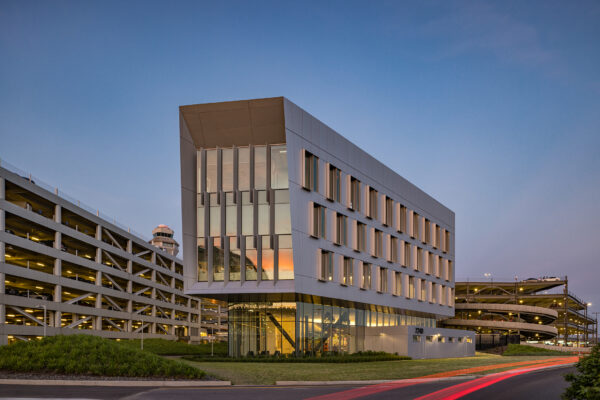
Port of Vancouver Terminal 2 Pavement Rehabilitiation Wins ACEC Honors Award
Through an on-call contract with the Port of Vancouver USA, GRI conducted a pavement evaluation at Terminal 2 to develop rehabilitation and reconstruction recommendations for approximately 6.5 acres of asphalt pavement. The pavement rehabilitation analysis was conducted to estimate the structural strengthening requirements based on the existing pavement structural capacity, the subgrade support conditions, and the estimated traffic loading. The structural analysis was based on: 1) pavement core and boring explorations, 2) Falling Weight Deflectometer (FWD) deflection test results, and 3) laboratory materials testing. Our geotechnical engineering staff found that pavement within Terminal 2 appeared to exhibit large areas of medium- to high-severity fatigue cracking, extensive non-load associated cracking, and deteriorated utility patches. These findings assisted the Port of Vancouver USA in determining that the majority of the pavement within Terminal 2 was in need of a full-depth repair.
For the west end of Terminal 2, where recognized contamination was present, GRI completed environmental sampling to better define the location of the contamination with respect to planned pavement recommendations. Because of this material, geotechnical and pavement engineers were tasked with managing hazardous material in a cost-effective way, while not creating a larger hazard. As a sustainable and low-impact reconstruction option, GRI selected full-depth reclamation (FDR) with cement stabilization as the preferred design alternative in order to nearly eliminate the need for removal and disposal of contaminated material.
Once complete, GRI in partnership with the Port of Vancouver successfully rehabilitated nearly 6.5 acres of asphalt pavement, mitigated contamination on site, and improved the safety on site for the Port of Vancouver USA and its tenants.
Uniqueness and/or Innovative Application of new or existing techniques
Typical standard of practice for pavement engineering is to perform a combination of soil borings and field quality assessment of soil support commonly available tools such as dynamic cone penetrometer (DCP) tests. While this information is useful in generally characterizing subsurface conditions, this approach lacks the refinement of more sophisticated, newer in-situ evaluation methodologies. One of these test methods is to conduct Falling Weight Deflectometer (FWD) testing. An FWD is a non-destructive pavement testing device that imparts an impulse load to the pavement structure that simulates a moving wheel load. Deflections measured at the pavement surface provide a direct measure of the pavement stiffness and in-situ resilient modulus of the pavement surface, aggregate base, and subgrade soil. Subgrade conditions are by far one of the most important parameters affecting pavement design. GRI owns and operates a KUAB 2M Model 150 FWD and conducted testing throughout the site. Because the testing gives a direct measure of the resilient modulus of the soil, it often allows us to develop designs that are less conservative and more cost effective than those based on empirical correlation equations such as those used with the DCP test.
GRI utilized Full-Depth Reclamation (FDR) as the preferred design alternative for areas requiring reconstruction. FDR is a tool that recycles existing pavement section in-place to rebuild new pavement. Rather than digging up old asphalt, sending the debris to landfill, and placing new pavement, FDR focuses on reusing and recycling material for an eco-friendly and cost-effective way to rehabilitate pavement. Although FDR is not a new tool, is has not been utilized as widely as a reconstruction technique until recently. FDR also helps to minimize the amount of trucks needed on site at construction projects, which introduces another sustainable element to a project that is aiming to stay “green.”
Future Value to the engineering profession and enhanced public awareness/enthusiasm of the role of engineering
Prior to the Terminal 2 Pavement Rehabilitation project, the Port of Vancouver USA had not previously utilized FDR technology for pavement reconstruction purposes. This was a new tool for their toolbox and one that they plan to depend on for future projects. In addition to this new tool, cement stabilization had also never been used for pavement design at the Port until now. These new tools and pavement engineering processes allows the Port to redefine the way that their pavement is handled in the future.
The enthusiasm revolving around this rehabilitation came directly from the owner and the tenants on site. Pavement is an element involved in everyone’s everyday lives but is also an element that is typically overlooked until it is need of repair or reconstruction. The rehabilitation to Terminal 2 increased the positivity for those who used the Port’s paved surfaced on a regular basis.
Social, economic, and sustainable development considerations
Sustainability: Terminal 2 utilized Full Depth Reclamation (FDR), which is a rehabilitation method that involves pulverizing an existing asphalt concrete pavement and its underlying layer(s), treating the material with cement, and shaping and compacting the material to form a new base layer. Recycling existing materials using FDR has numerous benefits such as:
- Reduced carbon footprint, since the material doesn’t need to be hauled away
- Cost effective
- Opportunity to improve the site geometry/layout
- Shortened construction schedule
- Increased structural capacity
- Increased durability
The pavement rehabilitation also helped to identify and define potential uncontrolled industrial compounds in the soil adjacent to the Columbia River. Generating soil data provided the owner with the ability to mitigate contamination that brings social and sustainable benefits to the region by the treatment or reduction of contamination in the environment. Because of the potential for uncontrolled industrial compounds in the soil, the benefits of the rehabilitation greatly impacted the environment of the site and surrounding areas, including the Columbia River. By paving a new surface that is not full of cracks, this greatly reduced the risk of contaminated material from leaching into the nearby river and being swept up in stormwater runoff.
Social: From a safety standpoint, the rehabilitated pavement in Terminal 2 greatly impacted individuals who would walk the site on foot. Before the rehabilitation, the pavement in Terminal 2 had widespread surface distress, cracking, patchwork, and an irregular surface – a major tripping hazard. There was also a previous load-related stressing hazard on the pavement. The potholes previously on the site created a negative impact on the trucks and other equipment that would regularly drive throughout the Terminal.
Economic: Assisting the Port with an upgrade to their facilities not only improved their relationship with their existing tenants, but also is an added benefit that future tenants will appreciate.
Complexity
Challenge: Understanding and working around the traffic loading at Terminal 2. Due to the semi-trucks, large forklift equipment, and tractor trailers that are used to dray steel slabs and other materials off of docked ships, Terminal 2 had non-uniform traffic patterns that needed to be understood in order to balance traffic loading design for the pavement design analysis.
Solution: Terminal 2 Project Manager and Lead Design Engineer Lindsi Hammond, PE, used her decade of pavement engineering experience and knowledge to help the Port tackle their traffic loads. She relied on her understanding of how traffic typically moves at Port facilities and worked hand-in-hand with the Port to gain an understanding of how much cargo was being transported through the Terminal. Hammond was able to closely work with the owner’s team to develop realistic traffic loading.
Challenge: Variable soil conditions. GRI engineers encountered silty, sandy, gravel in their borings at the site. The gravel in the borings ranged in size from less than 1 inch in size to more than 1 foot in diameter. Normally if you encounter gravel that is larger than 3 inches in diameter in your borings FDR is not an option.
Solution: The composition of the soils and fill material that were occupying the rehabilitation area had the right balance of enough fine grain, silt material and sand to help facilitate movement of the larger rocks so that the carbide cutting teeth of the FDR reclaimer were able to pull up these large rocks and keep them at the top, and push it forward, rather than pushing it back down in to the ground and into the pavement material.
Challenge: The project site is located in a historically industrial area with documented soil and groundwater contamination.
Solution: The compounds of interest were evaluated to address potential health risk to project construction workers. Soil samples were evaluated and tested to identify the contaminant concentrations and potential health risks from exposure. Furthermore, GRI was verified that using cement as a stabilizing agent was reactive, in a positive manner, with any contaminates in order encapsulate those materials into the future pavement base.
Challenge: The Port of Vancouver Terminal 2 was active and occupied throughout the entire duration of GRI’s pavement rehabilitation. All field work, design, and testing were conducted in a manner that would not negatively impact those working at the Port.
Solution: GRI personnel held Federal Identification credentials to gain clearance to work at the Port, required by the Coast Guard. Personnel on site became aware of the long shoreman’s (those employed by the Port to assist in loading and unloading cargo ships) schedule, and ensure that all work would be done outside of their active working hours at Terminal 2. Open communication and a general understanding of all schedules at the Port ensured that the pavement rehabilitation would not negatively affect anyone at the Port.




